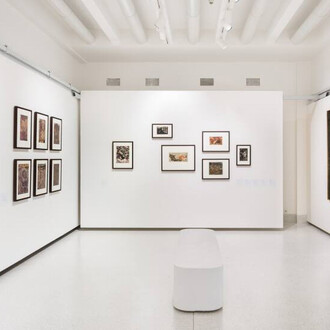The displayed works on paper – war-time drawings and prints created under the Protectorate of Bohemia and Moravia – are by members of Group 42 and were done at a time when they shared an artistic vision.
The group was founded on November 27, 1942 by like-minded friends who had already had joint exhibitions. They established a work group and chose the year of its founding as its name. They had a great deal of contact with cubism and surrealism; some were members of the Umělecká beseda art group. Despite – or because of – that, they adopted a program based on theoretician-formulated theses treating on new realism. They shared a capacity to poetize reality in a unique manner and to discover magic in the banality of civilist themes as “the mythology of modern life, i.e. the world in which we live”.
The new ideas were formulated by the group’s theoreticians Jindřich Chalupecký (1910–1990) and Jiří Kotalík (1920–1996). The group’s founders included painter and graphic artist František Gross (1909–1985), whose original vocabulary transformed the ordinary atmosphere of the city into new worlds governed by his principles – the exhibition shows his colour lithograph (Libeň) – or turned his war-time experiences into strange machines-creatures (Machine), which also appeared as illustrations for books of poems by well-known authors (Limbo and Other Poems by Jiří Kolář). Painter and graphic artist František Hudeček (1909–1990) was another prominent member. He translated his special sensitivity and curiosity about city suburbs into the character of a figure, a night walker with multi-form electric flux lines, which also appeared in Hudeček’s illustrations – on display are those for the poems The Unfamiliar Room by Jiřina Hauková or the collection Odes and Variations by Jiří Kolář. Like Gross, photographer Miroslav Hák (1911–1978) was born in Nová Paka. His photograph called Poëm shows his unique talent for observation and his effort to capture lived reality in a new, unmediated form. Sculptor Ladislav Zívr (1909–1980), too, came from Nová Paka and joined the group in 1943 with Hák. His figural drawings were based on the sculptor’s concept of the transformation of the human body into a metaphysical character (Female Torso), typically moulded in a compact manner. Poet Ivan Blatný (1919–1990), a founding member, wrote collections of poems as well as poems for children, such as Watching the Soccer Game or One, Two Three, Four Five, which was illustrated by another of the group’s founding members – painter, graphic artist and illustrator Kamil Lhoták (1912–1990). He created a rare artistic vision as a symbiosis of the contemporary world and a nostalgic view of the beginnings of technological civilization. He unfolded the extraordinary world of inventions, ranging from bicycles to airplanes, and tied in sporting activities as natural expressions of the modern era. He often painted them as suburban vistas (Shack, Hydroglisseur, The Garden-Machine). Another poet, Josef Kainar (1917–1971), established relations with Group 42 through Blatný. Besides literature and music, he concentrated on an artistic rendering of his motifs as geometric figures, interiors or heads (Figural Motif). Painter Jan Smetana (1918–1998) was another founding member. His displayed City View is a poetizing city vista in colours and diffuse light in the washed-out watercolour painting technique with distinct pen drawing. His captivation with the repeated motif of kerosene lamps in paintings, drawings and prints alike is reflected in his repeated examination of light effects in etching and aquatint (Two Lamps). Painter and graphic artist Jan Kotík (1916–2002), too, was a member of Group 42 from its very beginning. His work drew inspiration from various details of the urban space with expressively abstracted features of civilization (At the Table, View of the Street). Poet and translator Jiřina Hauková (1919–2005) cooperated with Group 42 from the moment it was founded, but only became a member in 1945. Poet Jan Hanč (1916–1963) joined the same year. Another poet, Jiří Kolář (1914–2002), had only produced literary works at the time the Group was established, though he had previously exhibited several collages. Painter and graphic artist Karel Souček (1915–1982) joined Group 42 with Kolář, but only exhibited with its members after the war. His drawings and prints capture the pulse of the streets and arcades with vistas of interiors through shop windows. His artwork on display shows the typical theme of a hairdresser’s studio with ghostly hairdryers (Street in the Rain, At the Hairdresser’s). Painter Bohumír Matal (1922–1988) became the last and youngest member after the war. He chose to paint the same themes of man, the city and the inventions of industrialization that he captured in geometric drawings of quotidian situations (Umbrella Man). He was also captivated by sports, discovering a motif that heralded his frequently adopted theme of cycling (Bicycle).
Group 42 came to an end in 1948, when the Sovietization and deformation of Czechoslovak society, including the arts, began. The Group’s members were to go in different directions in their lives and art alike, but their artworks and literature from the 1940s continue to represent a major element of our culture.
















